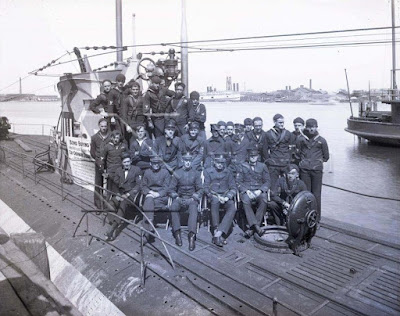A Third U-boat Visits Newport
Fans of Newport’s naval history should be well-acquainted
with the stories of the German submarines that appeared in Narragansett Bay and
its vicinity during the two world wars. SM U-53 paid a visit in 1916 when
the United States was still a neutral power, hoping to convince its leaders to
stay out of the war in Europe. Then in 1945, U-853 arrived off the East
Coast and was sunk near Point Judith just two days before
Germany surrendered. But did you know that a third U-boat came to Newport 100 years ago this past Sunday?
The United States spent approximately $32 billion fighting
the First World War, about 52 percent of its gross national product. Though the
war ended in 1918, efforts to pay off the bills persisted into the 1930s.
Organizers of the successful Liberty Loan campaign launched the fifth and final
war bond drive in 1919. They now had at their disposal captured German military
equipment to drum up sales, and those who purchased the bonds were treated to a
close-up look at the tanks, airplanes, and submarines they had read so much
about during the war.
One of those submarines was SM U-111. Surrendered at
Harwich, England on November 20, 1918, it underwent repairs and testing until
April when it was turned over to the United States Navy under the command of
Lieutenant Commander Freeland A. Daubin. Sailing under its own power, Daubin’s crew took U-111 across the Atlantic and arrived safely in Portland, Maine on April 18. After spending two weeks at the Brooklyn Navy Yard, U-111 joined four other captured U-boats to promote sales during the Victory Liberty Loan.
 |
U-111 in Boston
Boston Public Library
|
Following visits to Boston and New Bedford, U-111 appeared in Newport harbor early on the morning of May 5. Local
newspapers fanned the public’s curiosity by incorrectly reporting that U-111
was one of the U-boats responsible for torpedoing American vessels during
the war. According to the Newport Daily News, the U-boat “entered the
harbor flying the Stars and Stripes above the German ensign...The white and
black bunting appeared strange flying in Newport harbor and some remarked about
it, but when others called attention to the fact that it was flying below Old
Glory the critics seemed satisfied.”
The first thing most visitors noticed was its size. At 240
feet in length, U-111 was larger than the U.S. Navy’s submarines that
Newport’s residents were used to seeing at Goat Island. Those who purchased
bonds before their visit received permission to go inside the sub. According to
the Daily News’ reporter, “the change from the bright spring sunlight
and the fine air to the contracted interior, where the snugness of the quarters
seemed to take hold of one and give one a compressed feeling, was rather
oppressive. Many who went on board would have gone through about anything for
the satisfaction of being able to say they had been through a captured Hun
submarine.” Another feature that drew their attention was the deck
armament. U-111 mounted two four-inch guns which were “large guns in the
eyes of landlubbers.” Many visitors were unaware that U-boats carried
anti-submarine net cutters and were puzzled by the saw mounted on the
submarine’s bow.
 |
| Closeup of U-111's stern with Boston's Longfellow Bridge visible in the background Boston Public Library |
Unfortunately for Newport’s working residents, U-111 was
scheduled to be in Providence by 5:00 on the evening of the 5th. Its
late-afternoon departure meant that many never got the chance to see the
submarine before it left for the larger crowds anticipated in Rhode Island’s
biggest city. Still, the Liberty Loan salesmen did a healthy business in
Newport during this brief but tantalizing visit by one of America’s war
trophies.
Rob Doane
Curator
Naval War College Museum



Comments
Post a Comment